What is Clicker training?

Clicker training is a quick, easy and fun way to communicate and train your animal. The clicker is used to precisely mark the behaviors you want to see repeated as they are occurring. It is not a punishment, it is not a distraction or a way to get their attention, and it is not a toy. Clicker training is a means of communicating to your animal that you like the behavior they just offered and you want to see it repeated. It allows animals to think independently and offer different behaviors to figure out which is the one you want, which fosters learning. It also makes learning faster since the animals are consciously aware of the behaviors they are offering, and the sound of the click tells them exactly which one is being rewarded. The sound of the click tells the animal, "Yes, that is what I want to see!" while the absence of a click tells them, "No, try again". Clicker training does not involve verbal or physical corrections.
Animals become conditioned to expect a high value reward following each individual click. The sound of the click is an event marker (dolphin trainers use whistles instead of clicks) for the behavior you want. It is a unique and novel sound for your animal which means you will be rewarded. Reinforcement is often high value food rewards, toys, or praise / affection depending on your pet's motivation. The reinforcement is whatever your pet values most and is willing to work hard for. If they are so food motivated that dry dog kibble will keep them working, then use that. If they are easily excited and distracted, a higher value food reward should do the trick. If your pet loves a good tug or catch with a ball, use that as your reinforcement for the sound of the click.
If, for example, you use the clicker to teach a dog to sit, you should click! as they are crouching down into the sit.The sound of the clicker means the promise of a reward. This means that if you click, even by accident, your pet gets a treat! It is important to click at the appropriate time only and to always reward the behavior, otherwise the sound of the click looses meaning.
The faster you can click and reward your pet, the faster the learning process will be. If you are slow on delivery of treats, or use punishments and corrections intermixed with clicking, your pet will become confused, which will stump their learning ability. Clicker training utilizes the positive reinforcement form of operant conditioning. No punishments or corrections are to be used. Training should strengthen the bond between you and your animal and build trust. Your pet should be calm, confident, and engaging.
Why is this going to work better than other methods?

Clicker training can be used in all aspects of daily life with your pet. You can use clicker training to capture simple behaviors or you can use it to shape more complex behaviors. Clicker training is based on the operant conditioning style of learning and has been studied by BF Skinner since the 1930s. It has been scientifically tested on species ranging from dolphins, giraffes, hyenas, rats, fish, cats, walrus', guinea pigs, dogs and more. This method constantly reinforces your pet for the behaviors you want to see, which constantly keeps your pet learning and evolving on a daily basis. There are many techniques to clicker training which help animals learn simple behaviors such as sit and down, all the way to complex behaviors such as retrieving the newspaper or a drink from the refrigerator.
Positive reinforcement training means rewarding behaviors you like in order to increase the likelihood that these behaviors will repeat themselves. Simple behaviors using positive reinforcement training and the clicker can often be taught in one session. More complex behaviors can often be taught in several sessions. It is important to focus on what you want the animal to do rather than what you don't want them to be doing. If you don't want your animal to bark, teach "quiet". If you don't want them to jump up, teach "off". There is always something positive to teach in replace of the undesirable behavior, therefore, corrections and punishments are not needed.
Traditional, punishment based methods use physical force and control to get the pet to perform a behavior. These methods are based off of intimidation and fear. They build anxiety and frustration in your pet and can often result in a fearful or aggressive animal. We have pets for companionship. They are part of the family. It damages our bond with them when we view our pets as something to dominate and control. The result is an animal that often will ultimately fear their owner.
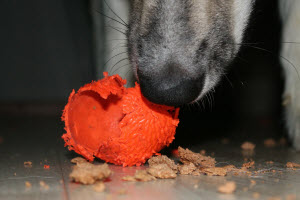
Note that "punishment" does not have to mean hitting your animal. Punishment can be anything the animal fears or views as negative. For example, jerking up on your pet's leash because they are pulling and you continue to jerk up until they stop pulling or sit. Their behavior stopped because of physical discomfort, but it did not teach the animal how to sit or stop pulling, and it does not tell the animal what they should be doing instead of pulling. Other forms of punishment include: noise cans, water bottles, hitting, yelling, muzzle grabbing, "alpha" rolling, saying "no", prong collars, shock collars, and more. Punishments may immediately stop your animal's behavior out of fear, but it does not correct the behavior or provide them with information on what to do next time.
The theory of dominance in wolves has been researched and scientifically disproven. Wolves are family units and do not over throw the "alpha" for control of the pack. Dogs recognize that we are humans, and not dogs, and they do have a social hierarchy with us. We can be good leaders for our animals by building trust and having a good relationship, not by exerting our dominance and control over them.
How do I start?
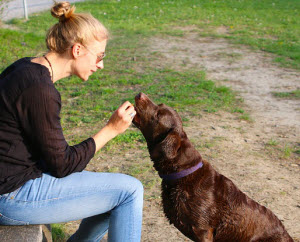
In order to best learn how to clicker train, you need to first learn your clicker mechanical skills. This means: How will you hold the clicker? How will you deliver the treats to your pet? What type of reinforcement will your pet work for? Set yourself and your pet up for success by being prepared before you start.
The clicker should always be in the same hand and should be the opposite of your treat delivery hand. Your treat delivery hand should always be in a neutral resting spot until you are ready to get out a treat as a reward after a click. This helps prevent your animal from keeping their eyes on your hand because there is a treat in it, and allows them to better focus on you and what behaviors they are performing at the moment of the click.
Next, you must "Charge the clicker". This part is very important as it conditions your animal to understand that the click symbolizes a reward. To charge the clicker you must click-treat, click-treat, click-treat, click-treat, about 10 times in a row. Your pet does not need to be doing anything in particular at all, just keep clicking and immediately rewarding with food so they begin to pair the sound of the click with a reward.
Your animal will decide what their reinforcement will be, not you. If food is the desired reinforcement, then you should have soft chewy treats the size of a pea that are easy to give and quick to eat, without causing stomach upset. If your animal is too distracted, anxious, afraid, stressed, or excited they will not be able to focus on you and the training. This can mean the reinforcement is not high value enough or the pet is too distressed in that particular environment to learn at the moment. Try changing the reinforcement or begin training in a calmer environment.
Other things to keep in mind while getting started with clicker training for your animal is the rate of reinforcement (how fast and how frequently you can click and treat), observation of their body language, maintaining clean mechanics, and length of each training session. The faster you can click and reward behaviors, the quicker the learning will be. Keep your hands in their appropriate place, observe their body language so you can click as a behavior is occurring and not after the fact. Lastly, keep training sessions short (5 minutes or less) and train a few times a day. You should always train for one behavior at a time. Wait until that behavior is learned and put on cue before moving on to the next behavior.
Beginning exercises
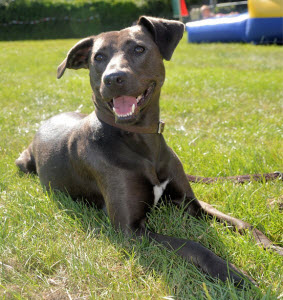
Once the clicker is "charged", and you have practiced your mechanical skills. Begin training simply, using easy cues that your pet can do successfully. This will increase their confidence and allow them to understand that communication and training is beginning.
Build basic foundation behaviors:
- Focus: click & reward the second your animal makes eye contact with you. This tells them to look to you for guidance and information. It also tells them, look at me not the treat bag. Do this exercise for about 1 minute with consistent eye contact. If your pet will not look you in the eye, begin clicking & rewarding when your pet glances your way or moves their head in your direction and build up from there.
- Name: Once you have consistent eye contact with your animal, begin saying their name each time they make contact and then click & reward. Do this exercise for about 1 minute with consistency. This will come in handy so that every time you call their name, they will look at you and you can give them guidance or cues from there. You cannot give a dog information to follow if they will not look at you.
- Sit: Sit is a very easy, natural behavior for a dog to offer. When your animal sits (as they naturally do) click & reward. Toss another treat out to the side of him so he must get back up and then try again. You can either wait for him to sit on his own and offer the behavior, or you can lure your pet into a sit by placing a treat at his nose and raising it up so that his nose is pointed to the ceiling. In order to still keep their eyes on the treat they need to sit, and you can click and reward for it! Repeat this exercise several times.
- Down: This exercise is similar to sit. Either wait for your pet to lay down naturally and capture the behavior as it occurs, or lure your pet to the floor by placing a treat at their nose and luring them slowly to the floor. Some pets may not lay down easily - lure them to the floor and wait for your pet to figure out what it is supposed to do. They will lick your hand, claw and paw your hand, bark, and many other behaviors to try to get the treat out of your hand. Eventually, they will lay down, and then you can click and treat them!
Training Tips:
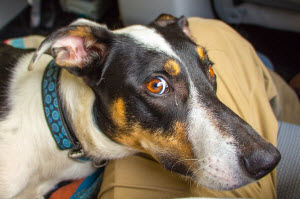
- If your pet keeps walking away from you or avoiding the training session: the environment is too overwhelming for him to concentrate in, the rewards are not high enough value for him, or he is becoming frustrated because he cannot figure out what you are asking of him, in which case you should end your session.
- Always end your training sessions on a successful note. If your animal did great, quit while you are ahead! If your animal is not figuring out the training, stop the session but play a game or go for a walk. Don't abruptly end any training session.
- Keep in mind, the clicker is doing the communicating for you. You should not be talking by giving verbal cues (yet) nor should you be correcting your pet for not getting it right. The absence of a click & reward says no so that you do not have to.
- Remember to keep your sessions frequent and short.
Adding a cue to a behavior:

A "cue" is a signal that provides information. When the doorbell rings, we know someone is at the front door. When the smoke alarm goes off, we know there is a fire, if someone gives us a "thumbs up" we know we did something good. Animals also pick up cues in their environment which tell them what is going on around them.
For training, cues are usually verbal signals or hand signals that tell your pet which behavior to perform. For example, the word "Sit" signals your pet to place their bottom on the floor. Clicker training does not put behaviors on a cue, but it tells the animal, "Yes! That is the behavior I want to see!" which increases the chance of that behavior repeating itself. Once an animal has repeated a behavior multiple times in a row, then give a signal (either verbal or by a hand gesture) just as the behavior is starting to occur. We don't want to repeat the word "stay" over and over again if the animal is not capable of "staying" reliably. It will teach them that the word "stay" doesn't actually have any meaning, or that "stay" means "get up and follow me". When an animal can correctlly "stay" several times in a row that tells us the animal knows exactly what they are doing and you can put that particular behavior on a cue. Have your pet repeat the behavior and give them a cue each time until they associate the cue with that behavior. Then, try giving the cue first and seeing if the behavior will follow. The clicker helps them learn to repeat the behavior, the cue will signal them to know which behaviors you are asking for at a specific time. Once the behavior is on cue, you no longer need the clicker for that behavior, but you should continue some form of reward, even if it is just praise.
Be careful not to use cues that are too similar in nature. For example, the word "down" is used to keep an animal "off" when jumping and is also used to ask them to lie down. Likewise, the universal hand signal for stay is often a flat hand up in the air, however, that is the same gesture you would make when asking for a high five or a shake. These types of signals will confuse your pet and make training more difficult for them.
Other techniques of training using the clicker:

Targeting: Target training is when an animal physically targets an object (end of ladle, post-it note, a toy, our hand) with part of their body (their nose, paw, or mouth). For example, teaching your pet to target your hand with their nose can help them learn how to greet a new person. Target training allows us to physically move an animal with having to physically move them. Following a target can help get your animal in and out of the car, have them retreat to their bed when guests arrive, go into their crate on cue, and more. The target acts as a lure, meaning the animal knows if they touch this conditioned target with their nose, they will get a reward. If you are holding the conditioned target in a car, over the scale at the veterinary hospital, or in their crate, they will follow it and touch it. They are now successfully and willingly getting in the car, on the scale, and in their crate without physical control.
Eventually the target will be faded out and this behavior can be put on a cue. If your dog already knows how to shake or high five, you have already been using the target method. They get a reward when they touch your hand with their paw. To begin a session, click and reward when your animal touches the palm of your hand or a fist with their nose. Then choose a physical target and begin clicking and rewarding whenever they touch it with their nose.
Capturing: Capturing means clicking and rewarding when your pet is doing something natural for them, such as: sit, stretching, or turning their head. When your pet is doing something you want to see more of, such as naturally being quiet, playing with a toy or walking nicely instead of jumping or pulling, click and reward! Use their natural behaviors to capture these moments, thus reinforcing the behavior and increasing the chance of it occurring more frequently. In order for your pet to learn, let behaviors occur naturally, try not to interfere.
Shaping: Shaping is a technique used to teach your pet to perform more complex behaviors such as retrieving a drink from the refrigerator, spinning, or performing sports like agility. It involves reinforcing small pieces of the puzzle step by step. The first step of shaping is always via targeting or capturing. Perhaps you want to teach your dog a good "fetch" behavior. You may capture when they look at or walk towards the toy, then you might wait for him to pick up the object (targeting it with his mouth), then reinforce him for holding the object for longer periods of time, then reinforce for coming to you, then reinforce for "drop it". Remember to click and reward frequently at every step of the process. This is often the most difficult technique to master for both you and your pet. Always plan the behavior you want to teach ahead of time. Think about where you should begin, where you want to end up, and the steps needed to get there.
Using the clicker in everyday life:
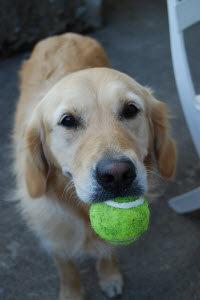
The clicker can be used in everyday life to reinforce the behaviors you want to see more of, and ignoring the ones you do not. It allows your animal to bond with you, builds a trusting relationship, builds confidence, teaches manners, provides mental and physical stimulation, allows them to think on their own, can help solve troublesome behavior, and promotes faster learning. Clicker training allows you to teach new things to your animal every day. It also continuously reinforces the good behaviors they demonstrate daily. For example, if you would like your pet to demonstrate more quiet, calm behaviors in the presence of people or other animals, use the clicker to click every time they demonstrate the behaviors you want to see.
The clicker is a fun way to train your animal, and people of all ages in the household can learn how to work with the clicker and participate in the training process. It will be your job to observe your pet's body language and click and reward at the right time. It will be the job of your trainer to show you how to teach each of the behaviors you want. Clicker training opens the door for two way communication and utilizes only positive reinforcement techniques that allow your animal to grow in confidence and allows them to think for themselves, creating strong learned behaviors and a stronger bond with you.
Christy Crosson, LVT, KPACTP, K9 Pawsitive Enrichment Training, LLC www.K9PetLLC.com
